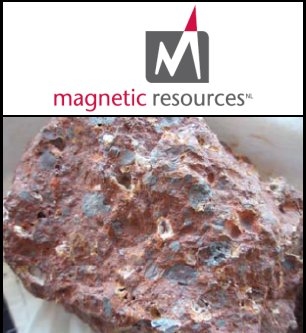
Magnetic Resources (ASX:MAU) Quarterly Activities Report to 31 March 2010
Perth, May 3, 2010 AEST (ABN Newswire) - Magnetic Resources ( ASX:MAU) Quarterly Activities Report to 31 March 2010, including the following summary. The full report is available from the link at the end of the release.
ASX:MAU) Quarterly Activities Report to 31 March 2010, including the following summary. The full report is available from the link at the end of the release.
IRON ORE
JUBUK (Magnetic 100%)
Magnetic Resources has received all the analytical results from its initial reverse circulation (RC) drilling programme testing the Jubuk Target 1 magnetite prospect near Corrigin in WA. The 1600m programme consisted of 11 RC drill holes and one diamond drill hole. The drill hole locations are shown in Figure 1.
The drilling has shown the presence of significant widths of near surface coarse grained magnetite in metamorphosed and re-crystallized banded iron formation with iron grades of about 25%Fe. If the iron is present as magnetite, this suggests a magnetite grade of approximately 35%.
Drill holes JRC01-7 and 10 returned the best results, located over an 800m strike length in the northern prospect area. The results include intersections of 16m @ 33.4%Fe from 44m in drill hole JRC01 and 32m @ 28.0%Fe from 63m in hole JRC06.
A cross section of drill holes JRC05 and JRC06 is shown in Figure 2. Drill holes JRC08-9 and JRC11 reported weaker than expected results, as a result this area is being investigated by examining the geophysical models to determine if the magnetic target under alluvial cover has been effectively tested.
After the end of the quarter Magnetic has received results of Davis Tube recovery (DTR) test work on a master composite sample from the RC drilling at Jubuk (ASX release 27 April 2010). The composite sample was compiled from RC drill intersections from drill holes JRC01, JRC05, JRC06 and JRC10 over a 600m strike length of the Target 1 magnetite BIF, to determine the DTR sizing for future analyses.
The development test work showed a DTR screen size of 75 microns should be used to give a sizing of 80% passing 53 microns. This sizing was achieved in the test work. The finalised DTR test was performed in triplicate on the master composite to give the results shown in the attached link (at end of release).
Jubuk Davis Tube Recovery Results
The iron grade, at close to 70%, is excellent and the low silica content in the concentrate, less than 2%, points to a quality, possibly Direct Reduction grade, product. These early test results indicate that the mineralisation at Jubuk can produce a high quality magnetite product with good iron recovery and that the mineral assemblage liberates well without the need for fine grinding.
Jubuk Target 1 is the first prospect to be tested out of three accessible targets identified by Magnetic to date at Jubuk (ASX release 5 January 2010). Geophysical modelling of downhole magnetic susceptibility results and ground magnetic data from Jubuk Target 1 is underway. The geophysical models have been used to plan a 3500m RC drilling programme to infill and extend the drilling on the Jubuk outcropping crystalline magnetite BIF and to test the nearby Target 2 where recent ground magnetic surveys indicate a 3km-long core to the target obscured by soil cover.
Subject to permitting, the drilling programme is scheduled to commence in late May.
REGIONAL ACTIVITY
Magnetic Resources has now completed a 3,480sq km high resolution aeromagnetic survey of its tenements over multiple target areas in the south west of WA (ASX release 17 February 2010). The aeromagnetic survey comprised about 16,280 line-km of flying on a 250m line spacing, in areas where much of the historic aeromagnetic data is based on a line spacing of 1,600m. The survey forms part of Magnetic's search for iron ore close to existing infrastructure.
This major survey coupled with other magnetic data has defined a total cumulative strike length of 254km of targets for the Mt Vernon, Wubin, Dalwallinu, Jubuk, Sewell and Quairading projects over 29 principal target areas.
Magnetic is targeting iron ore deposits ranging in size from 220Mt to 1000Mt within its various project areas (see inset in Figure 3) based on interpretation of geophysical data using an assumed specific gravity of 3.5 and projecting the targets to an average depth of 100m below surface. The potential quantity and grade is conceptual in nature as there has not yet been sufficient exploration to define a mineral resource and it is uncertain if further exploration will result in the determination of a mineral resource.
Currently Magnetic is talking to rail authorities and experts in respect to possible iron ore operations using existing railway networks close to Magnetic's tenements and targets.
The targets within the Wubin area tenements are all within 12km of the Wubin- Perenjori railway line which passes through the tenement. At Cubbine Hills tenement situated directly north of Quairading, the BIF outcrops and associated anomalies are less than 13km north of the Quairading railway line highlighting the proximity of some of the targets to existing infrastructure.
Magnetic Resources has expanded its search for iron ore by applying for a new tenement at Malara covering a substantial magnetic anomaly (see Figure 4) north of the Tallering Peak iron ore operation. The Malara tenement is located 60km north of Tallering Peak and 210km by road from the Geraldton port. Magnetic proposes to inspect the Malara area on the ground as soon as possible as the regional mapping data suggests much of the area of the anomaly is under cover or is granitic in character, however the intense magnetic anomaly in the area does not support this premise.
Sampling on Magnetic's extensive iron ore tenements in the Mid West and South West regions of Western Australia has commenced. The tenements, which now total some 5,300sq km in area, cover numerous iron ore targets identified from interpretation of regional aeromagnetics followed by detailed aeromagnetic surveys to refine and prioritise targets. Magnetic is targeting both magnetite and direct shipping ore (DSO) types in areas of good infrastructure close to railway lines and ports. The location of Magnetic's iron tenements is shown in Figure 3.
Preliminary sampling has identified a range of iron ore types varying from coarse grained crystalline magnetite BIF such as encountered at Jubuk (see Figure 5) to more massive goethite-hematite identified at Woobin (see Figure 6). A cemented pisolite type was also identified in two locations at the Woobin project (see Figure 7). The extent of the goethite-hematite and pisolite types of mineralisation has yet to be determined. Samples from these localities are currently being analysed.
Access agreements have either been signed or are being completed over Mt Vernon, Harris, Rock Dam Hill exploration licences. Geological mapping has shown negligible outcrop in the areas for sampling and magnetic data has been modelled to define targets for drilling. Permitting is in progress for a first pass air core drilling programme, to define the size, character and position of the target units for later RC drilling.
URANIUM
LAKE HARVEY (Magnetic 100%)
First pass soil sampling has been completed over several radiometric anomalies in the central portion of Magnetic's exploration licence using a 400m x 400m offset array. This sampling has identified extensive anomalous areas with a maximum value of 196ppm uranium (233ppm U3O8).
The distribution of anomalous soil geochemistry is shown in Figure 8. These anomalous geochemical responses define two zones totalling approximately 4km in length and up to 800m in width. It is not known at this stage if the geochemical anomalism extends at depth under the lake sediments.
Wide spaced shallow historical drilling carried out in the 1970's (to maximum depth of 12m) peripheral to the lake system did not return anomalous results, neither did the one hole which tested the radiometric anomaly in the southwest part of the soil sampling area. However the historical drilling did intersect strongly anomalous results on a small clay pan situated 1km to the north of the soil sampling area, where 2m @ 200pmm uranium was intersected from surface. Preparation and permitting of scout drilling to follow up these encouraging results is in hand.
SEABROOK (Magnetic 80%, earning up to 100%)
Extensive areas of anomalous uranium in soils and lake sediments have been identified by Magnetic's sampling of radiometric anomalies. The sampling has identified anomalous levels of uranium of up to 50ppm uranium from soil sampling and up to 249ppm uranium in hand auger samples from this lake and the associated palaeochannel system.
A 160-hole, 3,500m aircore drilling programme has been completed testing the extent and tenor of uranium mineralisation and particularly its distribution at depth in the lake sediment in the areas of defined uranium anomalism. The drilling also tested the geometry and type of the basement to the lake and palaeodrainage channels in order to verify the mineralisation model being applied to this area. The location of the drilling 8 is shown in Figure 9. Analytical results have been received for approximately 30% of the drill samples to date with a maximum U response of 45ppm over a 2m interval.
The results and project will be reviewed when all analytical data has been received.
GOLD
TAMPIA NORTH (Magnetic 80%, diluting)
The Tampia North tenements, where Magnetic holds an 80% interest with rights to earn a 100% interest, cover a 30km strike on an interpreted shear zone where gold anomalies and indications of gold mineralisation have been outlined by geochemical sampling and shallow drilling. The tenements are subject to a farmin agreement with Pacific Ore Ltd.
A soil sampling program has defined several areas for RAB drilling to determine the source of the surface anomalism. A 46-hole, 1,800m drilling programme has been planned to cover both the gold anomalism and peripheral zones where pathfinder elements As and Mo show anomalism. Permitting for the programme is in progress with drilling expected to commence in the June quarter.
LAKE GRACE and HOLLAND ROCKS (Magnetic 100%, diluting)
The Lake Grace and Holland Rocks tenements cover a cumulative 60km strike length of an interpreted shear zone where geochemical sampling has identified several goldanomalous areas and where limited historical drilling reported a best intersection of 1m @ 34g/t Au from 94m at Lake Grace. The tenements are subject to a farmin agreement with Pacific Ore Ltd.
Delays have been experienced in negotiating land access agreements, however much of the Holland Rocks area is now accessible. Soil sampling is in progress at Holland Rocks together with those accessible areas at Lake Grace.
CORPORATE
As previously announced (ASX release 7 April 2010), Magnetic placed 3,960,230 fully paid shares to a combination of sophisticated and professional investors at an issue price of 40cents per fully paid share to raise $1.58million before costs. The funds raised will mostly be used to advance exploration on Magnetic's iron ore and uranium prospects in the southern Yilgarn region of WA.
For the Full Quarterly Report, please visit:
http://www.abnnewswire.net/media/en/docs/62775-ASX-MAU-489337.pdf
Contact
George Sakalidis
Managing Director
Tel: +61-8-9226-1777
Mob: +61-411-640-337
Email: george@magres.com.au
Roger Thomson
Technical Director
Tel: +61-8-9226-1777
Mob: +61-419-969-183
Email roger@magres.com.au
| ||
|





